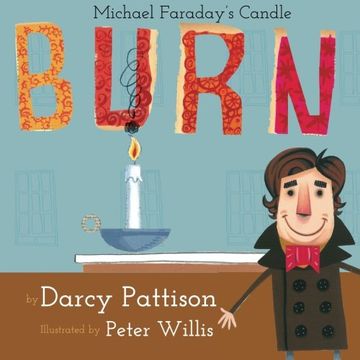Reseña del libro "Burn: Michael Farday's Candle (en Inglés)"
WHAT MAKES A CANDLE BURN? Discover the secrets of fire and candles. Solid wax is somehow changed into light and heat. But how? Travel back in time to December 28, 1848 in London, England to one of the most famous juvenile science Christmas lectures at the Royal Institution. British scientist Michael Faraday (1791-1867) encouraged kids to carefully observe a candle and to try to figure out how it burned. Known as one of the best science experimenters ever, Faraday's passion was always to answer the basic questions of science: "What is the cause? Why does it occur?" Since Faraday's lecture, "The Chemical History of a Candle," was published in 1861, it's never been out of print. Oddly, till now, it's never been published as a children's picture book. Faraday originally gave seven lectures on how a candle burns. Pattison has adapted the first 6000-word lecture to about 650 words for modern elementary students. Read this eloquent update of Faraday's candle lecture, perfect for today's student. Since Faraday's lecture, "The Chemical History of a Candle," was published in 1861, it's never been out of print. Oddly, till now, it's never been published as a children's picture book. Faraday originally gave seven lectures on how a candle burns. Pattison has adapted the first 6000-word lecture to about 650 words for modern elementary students. Read this eloquent update of Faraday's candle lecture, perfect for today's student. "Good, simple explanation of a complex chemical process. Great enrichment possibilities for teachers. I loved the illustrations, the science, and the British tone. Overall, thumbs up!" Deb Thrall, President, New Mexico Science Teacher's Association "With this delightful book, Darcy Pattison brings one of Michael Faraday's famous scientific lectures for children to a whole new generation of young learners. Peter Willis' colorful artwork illustrates Faraday's own explanations in a scientific, yet kid-friendly style. This book is a wonderful way to introduce children to this extraordinary scientist and to teach them about changes in matter with a familiar, yet remarkable, object - a candle." - Karen Ansberry and Emily Morgan, Authors of Picture-Perfect Science Lessons "Burn: Michael Faraday's Candle" is an exciting adaptation of Michael Faraday's (1791-1867) original special Christmas lecture, "The Chemical History of a Candle." Condensed from 6000 words to about 650 words for modern elementary education students, "Burn: Michael Faraday's Candle" is enhanced by dashing, colorful, quirky illustrations bring to life the original author's scientific lecture for juveniles, first delivered on December 28, 1848, at the Royal Institution in London, England. Mr. Faraday demonstrated several kinds of candles, including stearin, made of ox fat, a sperm candle made from the purified oil of the sperm whale, a bees-wax candle, and a paraffin candle, made from Irish peat bogs. Mr. Faraday taught everyone to observe experiments and ask, "What is the cause, why does it occur?" Mr. Faraday explains that capillary action explains who the flame in a candle gets hold of the fuel. Faraday continues to explain the oblong shape of the flame of the candle and the current of hot air draws out the flame, supplies it with air, and cools the sides of the cup of melted fuel. "Burn" is a brilliant reduction of a very famous British science lecturer that presents the information in a format appealing to children today.

